
Sea Surgeon's Dispensatory: 1 2 3 4 5 6 7 8 9 10 11 12 13 14 15 16 17 18 19 20 21 22 23 24 25 Next>>
The Sea Surgeon's Dispensatory, Page 24
Plasters
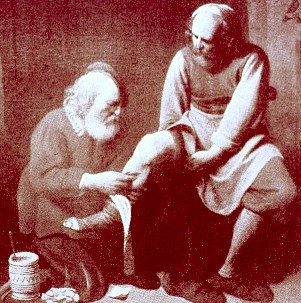
Photo: David Ryckaert - Plaster Application
Plasters include medicines in the form of plasters (or 'emplasters') and cerates (or prepared waxes). John Quincy notes that waxes are included because a cerate "is of a Consistence between and Unguent and a Plaster"1.
Quincy further explains, "An Emplaster is a Composition of Oils, Waxes, Resins, and Powders, &c. [etc.] in such a Consistence as will keep its Form without running or sticking to any thing when cold, but is yet moist enough to be melted and spread, so as to adhere when warm, and not be brittle or dry enough to crackle or break off when spread upon."2
Plasters are often applied to dressings as medicine to be applied to a wounds. Ephraim Chambers explains that they "are made up in a strong solid Body, that by remaining a long time on the Part, the Medicinal Ingredients, they are chiefly composed of, may have time enough to produce their Effect."3 The modern medicated Band-Ade is essentially a plaster.
Plasters were widely in use on ships to heal wounds, reduce swellings and heal fractures among other things.
1,2 John Quincy, Pharmacopoeia Officinalis & Extemporanea, 1719, p. 461; 3 Ephraim Chambers, "Emplaster", Cyclopedia, Vol. 1, 1728, p. 303
Cataplasma ad Squinanthi
Listed in: Moyle-Composition: Cataplasma ad Squinanthi1
Category: Compound - Ointments
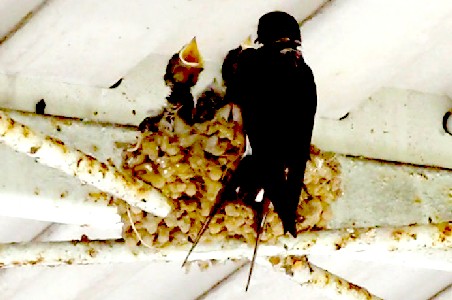
Photo: Cassiopeia Sweet - A Swallow's Nest
Rx: "Pulv. de nido Hyrund. [powder of swallows nest] alb. græc. [album graecum - dog turds] {of each 1-1/2 ounces} Figs, Dates, {3 of each} Pulv. lini [powdered flax] fenugr. [fenugreek] {of each 6 drams}, in aqua font. coqu. [cook in spring water] denique add [finally, add] Unguen. Dealtheæ [Ointment of Marshmallows] {2 ounces} Ol. Violar. [Oil of Violets] {1 ounce} Pulv. Croci. [powdered Saffron] {1 dram}, Vitell Ov. [egg yolk] {1 each} fiat Cataplasm [make into a cataplasm]."2
Description: "Against the Squinsie [peritonsillar abscess, behind the tonsil] and Inflammation of the Throat and Jaws."3
1,2,3 John Moyle, The Sea Chirurgeon, 1693, p. 21
Cataplasma Resolvens
Listed in: Moyle-Composition: Cataplasma Resolvens1
Category: Compound - Ointments
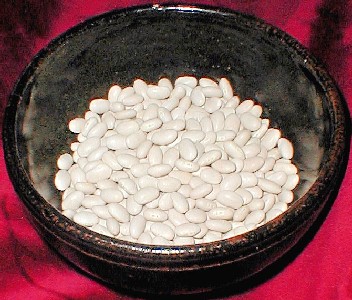
Photo: Heather Kennedy - White Beans
Rx: "Micam pan. [bread crumbs] alb. farin. fabar. [white bean flour] {of each, as much as is sufficient} Aq. fontan. coque ad consist. Cataplasm [cook in aqua fontana - spring water - to the consistency of a cataplasm] deinde adde [then put] Ol. Ros. [Oil of Roses] Camam. [Oil of Camomile] {as much as is sufficient} Pulv. Croci [powdered saffron] {1 dram}, misce. f. Cataplas. [mix and make into a cataplasm]."2
Description: "To mollifie [soften], discuss [disperse gathered humors], and ease pain."3
In explaining how to cure a wrenched or sprained joint, Moyle says, "I have sometimes taken away the pain and resolved the Tumor with that well known Pultis [Cataplasma resolvens] apply this warm and often and you will need no other Medicine."4
1,2,3 John Moyle, The Sea Chirurgeon, 1693, p. 21; 4 Moyle, p. 101
Cataplasma Suppurans
Listed in: Moyle-Composition: Cataplasma Suppurans1
Category: Compound - Ointments
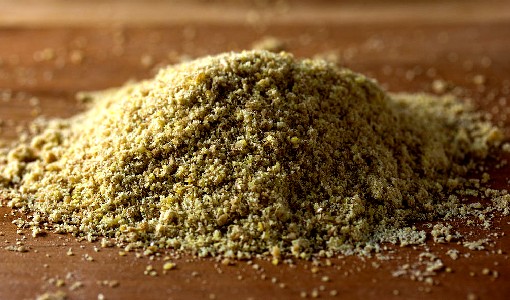
Photo: veganbaking.net - Ground Golden Flax Seeds
Rx: "Farin. Cem. Lini. [Meal of flax seeds] & Fenugrec. [Meal of fenugreek seeds]. {of each as much as is sufficient} Coque in [cook in] aq. hordea. [barley water] ad Cataplasm consist. [to the consistency of a cataplasm] denique adde [then add] Unguent Musilaginibus [Mucilage Ointment], & Ol. Lilior. [Oil of Lillies] {as much as is sufficient} Croci. [Saffron] {1 dram}, fiat Cataplas. [make it into a Cataplasm]."2
Description: "To suppurate [cause a wound to form pus - thought to be the corrupted humors coming to the surface of the wound] and break Aposthumes [abscesses]."3
1,2,3 John Moyle, The Sea Chirurgeon, 1693, p. 21
Emplastrum Ad Herniam (The Rupture Plaster)
Listed in: Moyle: Emplastrum Ad Herniam1
Category: Compound - Ointments

Photo: Christian Fischer - Osmunda Regalis or Water Fern
Rx: "Take of Galls, Cypress nuts, Pomegranate peels, Balaustines [Pomegranate Flowers], Acacia [Sloes], the seeds of Plantane, Fleawort, Watercresses, Acron [acorn] cups, Beans torrified [roasted], Birthwort, [roots] long and round, Mirtles [myrtles], of each half an ounce. Let these be powdered and steeped in Rose water four days, then torrified and dried, then take of Comfry the greater and lesser, Horstail Wood [Equisetum sylvaticum], Ceterach [Asplenium ceterach], the Roots of Osmond Royal Fern [Osmunda regalis, a Water-fern], of each an ounce, Frankincense, Myrrh, Aloes, Mastich, Mummy, of each two ounces; Bole Armenick washed in Vinegar, Lapis Caliminaris prepared, Litharge of Gold, Dragons blood, of each 3 ounces; Ship pitch two pound, Turpentine six ounces, or as much as is sufficient to make it into a Plaister according to art."2
Description: "It's Name shews it's good against Ruptures, Abortion, Tooth ach laid to the Tempils [temples]."3
"This Plaister is very binding and knitting, appropriated to Ruptures and burstness [burstings], as the title of it specifies. It strengthens the Reins [kidneys] & Womb, stays abortion or Miscarriage in Women; it consolidates Wounds, and helps all diseases coming of cold and moisture. If you mix a little Diapalma with it, it will stick the better."4
1 John Moyle, The Sea Chirurgeon, 1693, p. 35; 2 Nicholas Culpeper, Pharmacopœia Londinesis, 1720, p. 246; 2 Thomas Brugis, The Marrow of Physick, 1669, p. 25; 4 Culpeper, p. 246
Emplastrum Calaminaris
Listed in: Woodall: Emplastrum de lapide calaminari, or Grisium1
Photo: Nkansah Rexford - Mineral Calamine
Category: Compound - Ointments
Rx: "Take of Lapis Calaminaris prepared an ounce, Litharge, two ounces, Cerus half an ounce, tutty a dram, Turpentine six drams, white Wax an ounce and an half, Stags suet two ounces, Frankincense five drams, Mastich three drams, Myrrh two drams, Camphire a dram and an half, make it up according to Art"2
Description: “This Emplaster (I may speake of my owne experience) is a good healer of ulcers which are hard to bee cicatrized, and hath an especiall virtue in curing of buboes [a swollen, inflamed lymph node in the armpit or groin], as well venereal as pestilential: It is also the best incarnative [causing flesh to form in a wound] of all the Plasters that ever I used."3
1 John Woodall, the surgions mate, 1617, p. 43; 2 Nicholas Culpeper, Pharmacopœia Londinesis, 1720, p. 245-6; 3 Woodall, p. 43
Emplastrum Catagmaticum
Listed in: Moyle: Emplastrum Catagmaticum1
Category: Compound - Ointments
Humoral Property: dry2
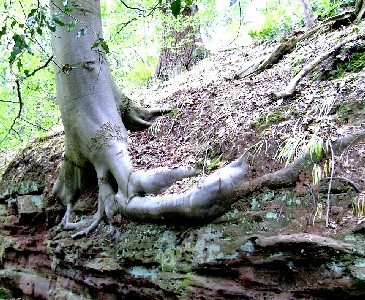
Photo: S.J. Wells - Ash Tree Roots
Rx: "Take of the juyce of Marshmallow roots six ounces; Bark of Ash tree roots, and the Leaves, the roots of Comfrey the greater, & smaller with their Leaves, of each two ounces. Mirtle [myrtle] berries an ounce and an half, the Leaves of Willow, the tops of St Johns wort, of each an handful and an half; having bruised them, boyl them together in red wine and Smiths water [water from a blacksmith's forge] of each two pound, till half be consumed; strain it and add Oil of Mirtles and Roses omphacine, of each one pound and an half; Goats suet eight ounces, boil it again on the consumption of the Decoction; strain it again, and add Litharge of Gold and Silver, red Lead, of each four ounces; yellow Wax 1 pound, Colophonia [rosin] half a pound, boil it to the consistence of a Plaister, then add clear Turpentine two ounces, Mirrh, Frankincense, Mastich, of each half an ounce; stir them about till they be boiled, and made into an Emplasiter according to Art."3
Description: "This Salve hath an excellent faculty in curing the fractures of Bones: for it helps and accelerates their coalition [union], when they are coagulated [solidified], increases their brawniness, foments [applies heat and moisture to] the innate calour [heat] of the part, and stayes the fluxions [flows] of humours."4
1 John Moyle, The Sea Chirurgeon, 1693, p. 35; 2 Nicholas Culpeper, Pharmacopœia Londinesis, 1720, p. 241; 3 Culpeper, p. 240; 4 Jean de Renou, A Medicinal Dispensatory, 1657, p. 728
Emplastrum de Betonica (Plaster of Betony)
Listed in: Moyle: Emplastrum De Betonica1
Category: Compound - Ointments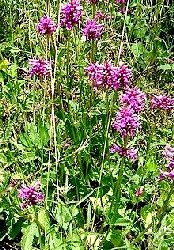
Wood Betony
Rx: "Take of green Betony, Burnet, Agrimony, Sage, Peniroyal, Yarrow [Achillea millefolium], Comfrey the greater, Clary (Whether by Galletrium they [the Royal College of Physicians in their Pharmacopoeia] mean wild Clary or Garden is in some question) of each six ounces, Frankincense, Mastich of each three drams: Orris [Iris], round Birthwort, of each six drams; white Wax, Turpentine, of each eight ounces; Gum Elemi, Oyl of Fir [I know no other Oyl of Fir, unless they mean Turpentine, and that was once before.] of each two ounces; white Wine three pound: Bruise the Herbs, boyl them in Wine, then strain 'em, and add the rest, and make them into a Plaister according to Art."2
Description: "It is a gallant Plaister to unite the skull when it is cracked, to draw out pieces of broken bones, and cover the Pores with flesh: It draws filth from the bottom of deep Ulcers, restores flesh, cleanseth, digesteth [promotes growth of healthy flesh] and drieth."3
"This is a very confus'd Composition, but it is pretty often used, and made in most [apothecary] Shops. It is said to strengthen the Nerves, and upon that account to do some good in some Disorders of the Head, apply'd upon the Sutures, to strengthen sprain'd Limbs and luxated [dislocated] Joints, to draw out Splinters, and digest and cleanse Ulcers; and likewise to give ease in the Gout and old Aches: but all these are hardly consistent, nor can any thing of consequence be depended upon from it."4
1 John Moyle, The Sea Chirurgeon, 1693, p. 35; 2 Nicholas Culpeper, Pharmacopœia Londinesis, 1720, p. 239-40; 3 Culpeper, p. 240; 4 John Quincy, Pharmacopoeia Officinalis & Extemporanea, 1719, p. 462
Emplastrum de Minio (Red Lead Plaster)
Listed in: Woodall: Emplastrum de Minio1, Moyle: Emplastrum De Minio2
Category: Compound - OintmentsHumoral Property: cool and very dry3
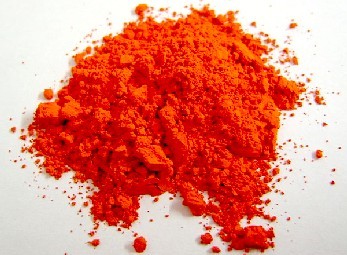
Photo: Wiki User BXXXD - Red Lead (Lead Oxide) Pulverized
Rx: "Take of red Lead 9 ounces, Oyl of red Roses one pound and an half, white Wine Vinegar six ounces, boil it into the perfect body of a Plaister. It is prepared without Vinegar thus; take of red Lead one Pound, Oyle of Roses one pound & an half, Wax half a pound, make it into a Plaister according to art."4
Description: "This Minium-plaster [plaster made of red lead] is a good discusser [disperser] of hotte humors, a good [as]swager of paines, mollifieth [softens] well, repelleth [unwanted humors] somewhat, and is very commodiously used upon wounds and ulcers to further good healing: it induceth also a good ciccatrize [healing a wound over with a scar]. In the tumour of scrotum, or rather of the Testicles called Hernia humoralis, commonly following the suddaine stopping of Gonorrhea, it is very convenient anodine [pain relieving] and discussing [dispersing] Plaster"5.
"Some ...apply it as a Strengthner to the Reins [kidneys] and sprain'd Limbs."6
1 John Woodall, the surgions mate, 1617, p. 43; 2 John Moyle, The Sea Chirurgeon, 1693, p. 35; 3,4 Nicholas Culpeper, Pharmacopœia Londinesis, 1720, p. 248; 5 Woodall, p. 43; 6 John Quincy, Pharmacopoeia Officinalis & Extemporanea, 1719, p. 468
Emplastrum de Ranis (Plaster of Frogs)
Listed in: Moyle: Emplastrum de ranis cum {Mercury}1, Tweedy: Empl. de Ranis [cum Mercurio]2
Category: Compound - Ointments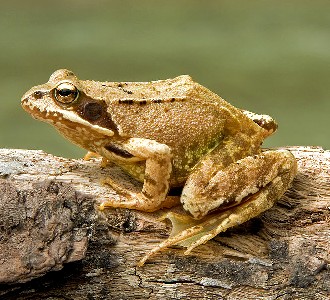
Photo: Richard Bartz - European Common Frog
Rx: "Take six live Frogs, worms washed in white Wine three ounces and an half, Oyl of Chamomel, Dill, Spicknard and Lillies of each two ounces: Oyl of Saffron one ounce, of Bays one ounce and an half, the fat of an Hog and a Calf of each one pound, Viper's fat two ounces and an half, Euphorbium five drams, Frankincense ten drams, juice of the roots of Elecampane [Inula Helenium] and also Dwarf Elder of each two ounces, Squinant [lemon grass], Stœchas [lavender], Mugwort [Artemisia] of each one handful; and Wine two pound, boyl them to the consumption of the Wine strain it and add one pound of Litharge of Gold, Turpentine three ounces, white Wax as much as is sufficient to make it into a Plaister, and adding to the end when it is removed from the fire, liquid Styrax an ounce and an half stirring it [a]bout with a spatole [spatula]. Lastly the mass being warm, add Quick silver four ounces killed in the Turpentine and liquid Styrax and incorporate them very well together."3
Description: "This wonderfully resolves [elminates] and discusses [disperses] hard Tumours and Nodes, whether Scrophulous or Venereal, or indeed from any other Cause. It will likewise reach the Seat of Arthritick Pains, and often ease them by attenuating and fitting the Matter for Transpiration [removal via sweating]."4
"This is justly complain'd of for a very troublesome Composition, tho when made, is of great value, and much in use."5
"As India, by the institution of Nature, first produced both the Venereous Pox [syphilis] and its Remedy: so Italy, which which first infected Europe with this Disease, refects [refreshes] the same with the best Medicament: for Joannes de Vigo, an Italian [15th/16th century physician], consulting his own (it may be) and Countreys good, composed this Emplaister, of eximious [distinguished] vertue, for the cure of the Italian, which they ineptly call the French disease [de Renou was French - it was common at this time for one country to blame another for introducing syphilis to the world as can be seen in his explanation]"6.
1 John Moyle, The Sea Chirurgeon, 1693, p. 35; 2 "158. John Tweedy's Bill for Medicines. November 8, 1743". Privateering and Piracy in the Colonial Period Illustrative Documents, John Franklin Jameson, ed., p. 460; 3 Nicholas Culpeper, Pharmacopœia Londinesis, 1720, p. 249; 4 John Quincy, Pharmacopoeia Officinalis & Extemporanea, 1719, p. 469; 5 Quincy, p. 468; 6 Jean de Renou, A Medicinal Dispensatory, 1657, p. 730
Emplastrum Defensivum (Defensive Plaster)
Listed in: Tweedy: Emplast. Defensiv.1Category: Compound - Ointments
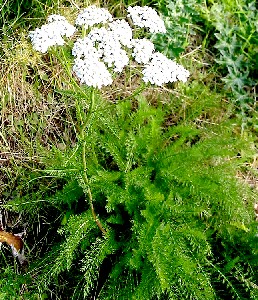
Photo: Georg Slickers - Yarrow (Achillea Millefolium)
Rx: "Take of Juice of Shepherd's-Purse [Capsella bursa-pastoris], Knot-grass [Polygonum], Horse-tail [Equisetum], Yarrow [Achillea millefolium], Plantain, the greater Houseleek, common Nightshade, and the greater Comfrey, each half a Pint; of Olive Oil, three Pints; of Hog's Lard, two Pounds: of Litharge of Gold, two Pounds and a half; and of red Lead, half a Pound: Boil them up together almost to the Consistence of a Plaister, and dissolve therein of yellow Wax and white Rosin, each four Ounces; then add of Olibanum and Venice Turpentine, each four Ounces; as also the following Ingredients reduced to Powder, viz. of Bole Armeniac, a Pound; of greater Comfrey-root, Pomegranate bark, Balaustins [Flowers of Pomegranates], Mastich, Dragon's-blood, and red Saunders, each two Ounces: Mix them, and make thereof a Plaister according to the Rules of Art. The Plaister may also be made without the Juices."2
Description: "This an astringent [medicine that draws the body's tissues together]."3
In another, later recipe for a defensive plaster, apothecary John Quincy's book explains their purpose a little better. "This plaster is laid round the lips of wounds and ulcers, for defending them from inflammation, and other ill symptoms; which it is supposed to effect, by somewhat constringing [contracting - the purpose of an astringent] the vessels, and thus preventing the afflux [flow] of humors to the part."4
1 "158. John Tweedy's Bill for Medicines. November 8, 1743". Privateering and Piracy in the Colonial Period Illustrative Documents, John Franklin Jameson, ed., p. 458; 2,3 Robert James, Pharmacopoeia Universalis, 1747, p. 756; 4 John Quincy, Pharmacopoeia Officinalis & Extemporanea, 1782, p. 494
Emplastrum Diachalciteos
Listed in: Woodall: Diacalcitheos1
Category: Compound - OintmentsHumoral Property: "of temperament it is cooling and drying"2; "very drying"3
Photo: Wiki User BXXXD - Colcothor (Iron III Oxide),
Formerly the Source of the Name of this Plaster
Rx: "Take of Hogs grease, fresh and purged from the Skins two pounds; Oyl of Olive Omphacine, Litharge of Gold beaten and sifted, of each 2 pounds; white Vitriol burnt and powdered four ounces; Let the Litharge, Grease and Oyl boyl together with a gentle fire, with a little Plantane water, always stirring it to the consistance of a Plaster into which (being removed from the fire) put in the Vitoral [vitriol] and make it into a Plaster, according to Art."4
Description: "This Emplaster mitigateth paine; it is a good defensative against all venomous [poisonous - corrupted] humours, and will very well induce a cicatrice [healing over with a scar] in wounds and ulcers: also it hath an especially good qualitie to asswage the paine in the small of the backe, proceeding from distempered kidnies, by hot causes, as well concerning the [kidney and urinary tract] stone, and gravell, as in the Gonorrea: and dissolved or relented with oile of roses or elders, or of linseed, it is a very good medicine to heale burnings and scaldings. It was devised first by Galenus [Galen of Pergamon]"5.
"Before [in other, previous dispensatories] it was called Diaplama, because of the branch of Palm-tree [used in those previous recipes] and Diacalciteous, because of the Calcitis [colcothar - a brownish-red ferric oxide] in it. But now neither of both be in."6
1,2 John Woodall, the surgions mate, 1617, p. 41; 3 Nicholas Culpeper, Pharmacopœia Londinesis, 1720, p. 242-3; 4 Culpeper, p. 243; 5 Woodall, p. 41; 6 Culpeper, p. 243
Emplastrum Diachylon cum Gummi
Listed in: Woodall: Diachilion magnum cum gummis1, Moyle: Emplastrum Diachalon cum Gumis2, Tweedy: Emplast. Diachylon c' G.3
Category: Compound - Ointments 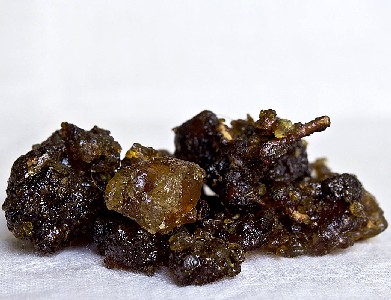
Photo: Wiki user Jacopo188 - Bdellium Resin
Humoral Property: "it is of temperament warme, and moist"4
Rx: "Take of Bdellium, Sagapenum, Ammoniacum, of each two ounces dissolved in Wine and added to the mass of Diachylon magnum [a compound plaster containing a wide variety of simples including a mucilage of raisins, figs, mastic, mallow roots, flax seeds, fenugreek seeds and the oils of sheeps feet, iris, chamomile and dill - among several other simples]: first boil the Gums being dissolved to the thickness of Honey."5
Description: "This Emplastrum dissolveth, maturateth [brings to a head], and mollifieth [softens] hardnesses, & is principally good in Apostumes [swollen abscesses], ...it was first devised by a certaine ancient Artist named Serapis, and Avicenna [10th century Persian physician] as some thinke invented it; but others judge that Mesues [8th/9th Assyrian physician Yuhanna ibn Masawaih] was the inventor thereof."6
1 John Woodall, the surgions mate, 1617, p. 41; 2 John Moyle, The Sea Chirurgeon, 1693, p. 35; 3 "158. John Tweedy's Bill for Medicines. November 8, 1743". Privateering and Piracy in the Colonial Period Illustrative Documents, John Franklin Jameson, ed., p. 458; 4 Woodall, p. 41; 5 Nicholas Culpeper, Pharmacopœia Londinesis, 1720, p. 243; 6 Woodall, p. 41
Emplastrum Diachylon Parvum
Listed in: Woodall: Diachilon parvum1
Category: Compound - Ointments
Humoral Property: "I hold it to be of temperament cold, the rather, by reason of the much Litharge in it, if a minerall may be called either hot or cold Litharge, cold it is without question."2
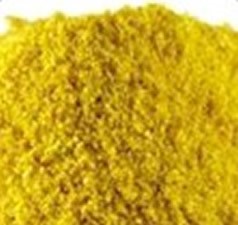
Litharge of Gold (Lead Sub Oxide)
Rx: "‘[Diachylon Simplex] Take of Mucilage of Fœnugreek and Linseeds, and of Marshmallow Root, ana {1 pound} of old Oil that’s fine, {3 pounds} of Litharge of Gold, {1.5 pounds} to make the aforesaid Mucilage, take of Fœnugreek and Linseeds, and of Marshmallow Roots, ana {3 ounces} of common Water, {6 pounds}: Let the Litharge be finely powdered and mixed with the Oil, then boil it over a gentle Fire, stirring it all the while with a Spatula, until it grows thick as the Consistence of Honey. Take it from the Fire, and let it leisurely cool, and then mix it with the Mucilage, and gently boil it again to the Consumption of all the aqueous Humidity, so as to make it into a Plaister, S.A. [Secundem Artem - According to Art]’
...
What is given in the Auguston Dispensatory under the Title of ... Diachylon Par[v]um ...differs only in adding Henbane and Fleawort Seeds to the Muscilage."3
Description: "This Emplaster is very good to dissolve schirras [cancerous or hard growths], tumours of the liver, spleen, reines [loins], belly, or elsewhere; it is wholly composed of mollifying [softening] and discussing [dispersing] ingredients; it serveth generally for hot or cold causes, but chiefly for hot: ...It was devised by Mesues[8th/9th Assyrian physician Yuhanna ibn Masawaih]."4
1,2 John Woodall, the surgions mate, 1639, p. 28; 2 John Quincy, Pharmacopoeia Officinalis & Extemporanea, 1724, p. 516; 4 Woodall, p. 28
Emplastrum Diapalma
Listed in: Moyle: Emplastrum Diapalma1. Tweedy: Emplast. Diapalm.2
Category: Compound - Ointments
Photo: Jorge Elías - Palm Leaf
Rx: "Take Litharge of Gold, and of Olive Oil, each three Pounds; of Hogs Lard, two Pounds; and boil them together, keeping them continually stirring, till they become a Plaister. To which, if there be added four Ounces of burnt Chalcitis [colcothar - a brownish-red ferric oxide], or calcined white Vitriol, it becomes Dialchalciteos, or Vitriol Plaister."3
Description: "It cures green [fresh] wounds, pestilent tumours and exitores [probably exitour - a running sore]; as also Ulcers, Bruises and divelled [split or pulled open] parts."4
As the latter part of the above recipe shows, this is the plaster which became Dialchalciteos. It is curious that Dialchalciteos is prescribed by the earliest sea surgeon writer under study (John Woodall), while the much older Diapalma is recommended by both of the later writers.
Another interesting issue with this plaster is the name - it basically means Plaster of Palm, yet it contains no palm. Physician Nicolas Culpeper notes in his entry on Diacalciteous that it used to contain "the branch of Palm-tree" although that has been removed from the recipe."5 French physician Jean de Renou says that "Myropolists and Chirurgeons [surgeons] rather from Custom then Reason retain this Name of Diapalma"6.
It could be argued that this and Diachalciteos are basically the same thing (and are used for the same purpose) and so this entry should be grouped with that, however there is a small difference, so for clarity they are listed here separately.
1 John Moyle, The Sea Chirurgeon, 1693, p. 35; 3 "158. John Tweedy's Bill for Medicines. November 8, 1743". Privateering and Piracy in the Colonial Period Illustrative Documents, John Franklin Jameson, ed., p. 458; 3 Robert James, Pharmacopoeia Universalis, 1747, p. 757; 4 Jean de Renou, A Medicinal Dispensatory, 1657, p. 722; 5 Nicholas Culpeper, Pharmacopœia Londinesis, 1720, p. 243; 6 Renou, p. 722
Emplastrum Epispasticum (Compound Blistering Plaster)
Listed in: Tweedy: Emplast. Epispastic1
Category: Compound - Ointments
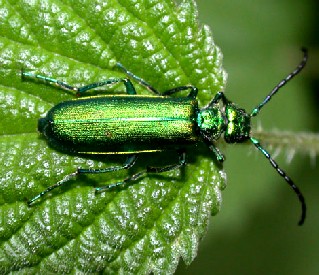
Photo: Franco Christophe - Spanish Fly, Source of Cantharides
Rx: "Take of Mustard seed, Euphorbium, long Pepper, of each one dram and an half; Stavesacre [Delphinium staphisagria or lice-bane], Pellitory of Spain of each two drams: Ammoniacum, Galbanum, Bdellium, Sagapen, of each three drams: whoe Cantharides (Must you not put them whole into the Plaister?) five drams: Ship Pitch, Rozin, yellow Wax of each six drams: Turpentine as much as is sufficient to make it into a Plaister."2
Description: "Many people use to draw Blisters in their Necks for the Tooth ach, or for Rheums in their Eyes. [This is a practice to draw unwanted humors away from the troubled area; the blisters work as a fontanel.] If they please to lay a Plaister of this there, it will do it."3
"There are various ways of making this Plaster, and almost every one has something in it particular, but the Flies are the chief; and if they be stuck upon any Plaster whatsoever that has none in it after it is spread, it will not fail to draw; tho they are preferable which have Flies enough in their Composition, and will stick of themselves; because the Blisters rais'd with such are much more easily dressed, the Skin very readily following the Plaster, when taken off. The perpetual Blisters which some make such an undeserved stir about, 'are nothing more than a common Epispastic; and they are kept open by a mixture of the Flies, finely powder'd with what they are dress'd with every day."4
1 "158. John Tweedy's Bill for Medicines. November 8, 1743". Privateering and Piracy in the Colonial Period Illustrative Documents, John Franklin Jameson, ed., p. 458; 2,3 Nicholas Culpeper, Pharmacopœia Londinesis, 1720, p. 245; 4 John Quincy, Pharmacopoeia Officinalis & Extemporanea, 1719, p. 472
Emplastrum Melilotum Compositum
Listed in: Moyle: Emplastrum DeMeliloto Compositum1
Category: Compound - Ointments
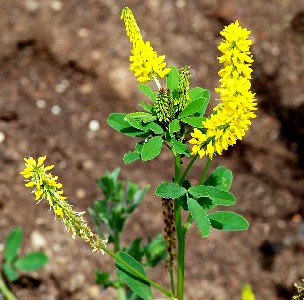
Photo: Wiki user Alvesgaspar - Melilot
Rx: "Take of Melilot flowers 6 drams, Chamomel flowers, the seeds of Fenugreek, Bayberries husked, Marshmallow roots, the tops of Wormwood and Marjoram, of each three drams; the seeds of Smallage, Ammi [probably Ami Majus - also called bishop's weed or bullwort], Cardamoms, the roots of Orris [Iris], Cyperus, Spicknard, Cassia lignea, one dram and an half. Bdellium 5 drams. Beat them all into fine powder, the pulp of twelve Figs, and incorporate them with a pound and an half of Melilot plaister simple, Turpentine an ounce and an half, Ammoniacum dissolved in Hemlock Vinegar 3 ounces. Styrax five drams, Oyl of Marjoram and Nard, of each half an ounce, or a sufficient quantity; make it into a Plaister, with a hot mortar and pestile without boyling."2
Description: "It mollifies [softens] the hardness of the Stomach, Liver and Spleen, bowels, and other parts of the body: It wonderfully asswageth pain; and easeth Hyprochondriack Melancholly [referring to black bile, one of the bodily humors, causing problems in the upper abdomen], and the Rickets."3
"This is a tedious troublesome Composition, and worth little when it is done; tho it just keeps a place in the [apothecary] Shops, but is not much taken notice of. It stands recommended for a warm Discutient [disperser of matter], but this is less likely to answer such an Intention, than as it was formerly directed in the old College-Dispensatories; for in this [recipe] many of the warmest and best Ingredients, [such] as the Melilot simple and the Ammoniacum, are quite left out, or lessen'd in their Quantities"4.
1 John Moyle, The Sea Chirurgeon, 1693, p. 35; 2 Nicholas Culpeper, Pharmacopœia Londinesis, 1720, p. 247-8; 3 Culpeper, p. 248; 4 John Quincy, Pharmacopoeia Officinalis & Extemporanea, 1719, p. 467
Emplastrum Melilotum per Splene.
Listed in: Woodall: Empl. Melilotum per splene.1
Category: Compound - Ointments
Humoral Property: hot2; "of temperament it is warme"3

Photo: Wiki user Alvesgaspar - Melilot
Rx: "Melilot, six ounces: chamomile flowers, the plant absinth, marjoram, fenugreek, bay berries, root of marshmallow, three drams of each: seeds of wild parsley, bullwort [Ami Majus], cardamom, iris, nut grass [Cyperus rotundus], spikenard, cinnamon, a half dram of each: ammoniac, ten drams: storax, bdellium of each five drams: Turpentine ounce one and a half: twelve fat figs: "sepi caprini" [This is unclear. It might be goat's cheese or the herb goat's rue.], balm of each two and half ounces: Wax six ounces: oil of marjoram, oil of cloves as much as is sufficient: water, in which are cooked the fenugreek, Chamomile, Melilot. The quantity is ascertained by how much is needed for soaking."4
Description: "This Emplaster mollifieth [softens] all hardnesse of the liver, spleen, and ventricle; dissolveth windiness, ceaseth vehement paines provoked by winde; as namely, in the disease called flateus hipocrendriacus, which is a flatuous or windy paine gathered neere unto the Splene: it is also generally good against the gathering together of any congealed cold substance in the stomach or liver: ...[it is] comforting exceedingly: It was devised by Mesues [8th/9th Assyrian physician Yuhanna ibn Masawaih] an ancient writer."5
1,2,3 John Woodall, the surgions mate, 1617, p. 42; 4 Joannis Mesuae Da Masceni, De Re Medica Libri Tres, 1550, translated from Latin by the author, p. 405; 5 Woodall, p. 42
Emplastrum Melilotum Simple
Listed in: Woodall: Empl. Melilotum simplex1, Moyle: Emplastrum DeMeliloto Symp.2, Tweedy: Emplast. Melilot.3
Category: Compound - OintmentsHumoral Property: "it is of temperament hot and moist"4

Photo: Wiki user Alvesgaspar - Melilot
Rx: "Take of the purest Rosin 8 pound, yellow wax 4 pound, Sheeps suet two pound. These being melted, add green Melilot cut small two pound: make it into a Plaister according to Art."5
Description: "This is good in greene [fresh] wounds; for it draweth and healeth well: also it attracteth and bringeth forward a cold Aposteme, and is an especiall secret, and the best thing I ever knew in curing kibed [chapped and cracked] heeles and chilblanes: it... was devised by Mesues [8th/9th Assyrian physician Yuhanna ibn Masawaih]."6
"It is a gallant drawing and healing plaister, no way offensive to any part of the body. It cleanseth wounds of their filth, ripeneth swellings and breaks them, and cures them when it hath done. It is special good for those swellings vulgarly in London called Felons [paronychia - foot rot], in Suffex [they are called] Andicorns; only have a care of applying it to the Legs, because of its drawing quality; to any other part of the body, in a Sore that hath any putrifaction in it, it is none of the worst Plaister."7
1 John Woodall, the surgions mate, 1617, p. 42; 2 John Moyle, The Sea Chirurgeon, 1693, p. 35; 3 "158. John Tweedy's Bill for Medicines. November 8, 1743". Privateering and Piracy in the Colonial Period Illustrative Documents, John Franklin Jameson, ed., p. 458; 4 Woodall, p. 42; 5 Nicholas Culpeper, Pharmacopœia Londinesis, 1720, p. 247; 6 Woodall, p. 42; 7 Culpeper, p. 247
Emplastrum Oxycroceum
Listed in: Woodall: Empl. Oxycroccum1, Moyle: Emplastrum Oxicrocium2, Tweedy: Emplast. Oxycroceum3
Category: Compound - OintmentsHumoral Property: "of temperament it is hotte and moist"4
Photo: Wiki user alamout - Saffron Plants
Rx: "Take of Saffron, Ship Pitch, Colophonia [pine resin], yellow Wax of each four ounces: Turpentine, Galbanum, Mastich of each one ounce and three dreams. Let the Pitch and Colothonia be melted together, then add the Wax (it being removed from the fire) the Turpentine afterwards, the Gums dissolved in Vinegar; lastly the Saffron in powder well mixed with Vinegar, and so make it into a Plaister according to Art."5
Description: "This is a very ancient composition, but ascribed chiefly to Nicolaus [13th century Byzantine physician Nicholas Myrepsos] an ancient Writer as Author thereof, it is of quality anodine [pain relieving], attracting, mollifying [softening], and comforting: it asswageth paines in the goute proceeding of a cold cause, and is good in cold Aches, and by that attracting vertue it hath, it draweth out vapors (per poros cutis) or the sweate vents in the skin [it is used to cause sweating], whereby it often unladeth the body of vicious and noysome [unpleasant] humors which otherwise might indanger the Patient"6.
"It is of a notable softening nature and discussing [matter dispersing] quality, and helps broken bones and any parts molested with cold and old aches, stiffness of the Limbs by reason of Wounds, Ulcers and Fractures or Disolcations, and also dissipates cold swellings."7
1 John Woodall, the surgions mate, 1617, p. 42; 2 John Moyle, The Sea Chirurgeon, 1693, p. 35; 3 "158. John Tweedy's Bill for Medicines. November 8, 1743". Privateering and Piracy in the Colonial Period Illustrative Documents, John Franklin Jameson, ed., p. 458; 4 Woodall, p. 42; 5 Nicholas Culpeper, Pharmacopœia Londinesis, 1720, p. 249; 6 Woodall, p. 42; 7 Culpeper, p. 249
Emplastrum Stiticum (Paracelsus)
Listed in: Woodall: Emplastrum stipticum Paracelsi1, Moyle: Emplastrum Paracelsus2, Tweedy: Emplast. Paracels.3
Category: Compound - OintmentsHumoral Property: "it is of temperament warme"4
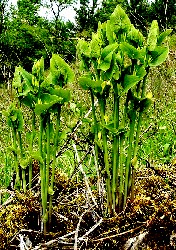
Birthwort
Rx: "Take Oil of Olives {6 ounces} yellow Wax {1.5 ounces} Litharge {2.5 ounces} Gum Ammoniacum, Bdellium, {of each 1/2 ounce} Galbanum, Opoponax, Oil of Bays, Calamine, long and round Birthwort, Myrrh and Frankincense {of each 2 drams} Turpentine {1 dram} Mix into an Emplaster S.A. [According to Art]."5
Description: "This composition devised by the famous Philosopher Philipus Theophrastus Paracelsus excellethe in the cure of piercing wounds, and scabs; as also in the cure of all dangerous wounds whatsoever; it hath the precedence as well for contused as insized [incised - cut] wounds, for it asswageth paine, defendeth from accidents, discusseth [disperses matter], mollifieth [softens], attracteth, digesteth [promotes growth of new flesh], incarneth [causes flesh to build in a wound], and consolidateth: and is also good for an old ach proceeding of a cold cause. It is further especiall good to ulcers on the legges or elsewhere in any part of the body: it is ...very comfortable [medicine]."6
"This is a kind of Diachylon with the Gums. It is a Composition directed by Paracelsus, and therefore is frequently call'd for by no other Name than Plaster of Paracelsus."7
1 John Woodall, the surgions mate, 1617, p. 40; 2 John Moyle, The Sea Chirurgeon, 1693, p. 35; 3 "158. John Tweedy's Bill for Medicines. November 8, 1743". Privateering and Piracy in the Colonial Period Illustrative Documents, John Franklin Jameson, ed., p. 458; 4 Woodall, p. 40;5 John Quincy, Pharmacopoeia Officinalis & Extemporanea, 1719, p. 469; 6 Woodall, p. 40; 7 Quincy, p. 470
Emplastrum Stomachicum
Listed in: Woodall: Emplastrum calidum1,Tweedy: Emplast. Stomach. Mag.2
Category: Compound - OintmentsHumoral Property: "of a very warme temperament"3
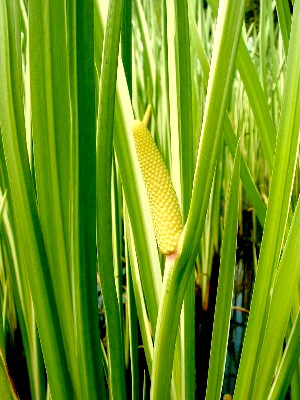
Photo: J.F. Gaffard - Calami Aromatici - Acorus Calamus
Rx: "Ligni aloes [aloe wood], absinthij [absinth], masticis [mastic], cyperi, costi [costus],
zingiberis [ginger], gummi Arabici [gum arabic], {of each 1/2 ounce} calami aromatici [Acorus calamus],
thuris [frankincense], aloes, {of each 3 ounces} cariophyllorum [cloves], maceris [mace - nutmeg hull],
nucis moschatæ [nutmeg], junci odorati [Cymbopogon schoenanthus or camel's hay],
florum nardi [flowers of spikenard], {of each 1-1/2 drams}.
Reduisez le tout en poudre & l'incorporez avec de la gelee de coings en consistence d'Emplastre, puis l'estendez sur un linge, & le saupoudrez de bois d'aloes pulverise. [Reduce everything to powder and stir with quince jelly to the consistance of a plaster, then spread on a cloth, and sprinkle on it powdered aloe wood.]"4
Description: "This Emplastrum stomachi or calidum is a composition described by Johannes Jacobus Wekerus [16th century German physician] under that name pag. 953. of his Dispensatorie [Le grand thrésor ou dispensaire et antidotaire]: it is only used where a comforting Emplaster of a very warme temperament is required: it is a needfull Emplaster in the Surgeons chest for it comforteth much the liver or stomacke debilitated by cold humors, and helpeth wel digestion, in want thereof Paracelsus Plaster though not so fitly, may serve."5
1 John Woodall, the surgions mate, 1617, p. 43; 2 "158. John Tweedy's Bill for Medicines. November 8, 1743". Privateering and Piracy in the Colonial Period Illustrative Documents, John Franklin Jameson, ed., p. 458; 3 Woodall, p. 43; 4 Johannes Jacob Wecker, Le Grand Thesor ou Dispensaire et Antidotaire, 1616, [Translated from Old French by the author], p. 1073; 5 Woodall, p. 43
Other Compounds
There are a couple compound medicines that don't really fit in the other categories, so they have wound up up here.
Lotion
Listed in: Woodall: Lotion1, Moyle: Lotionibus2
Category: Other Compounds
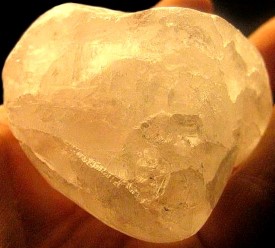
Alum
Rx: "A lotion [is] compounded of vulnerary [healing] hearbs in their prime gathered, and decocted [concentrated by boiling] with Allumenis [alum] and mell [honey] in aqua pura [pure water].... Only let me tell the Surgeons Mate, that in want of such a Lotion, though it be not in all points answerable thereto, yet he may make a good Lotion at sea of [only] fresh water, Allome, and Hony, provided he be wary not to bee to[o] plentifull of the Allome."3
Description: "This word Lotion, is a generall phrase with many Surgeons, as if there were no difference in lotions, whereas their differences are infinite: ... this Lotion [described above] I confesse may retaine a name generall as well as any one outward medicine I know; for well prepared, thereof good uses may be made, as namely and most commonly it is all in all to bee used as an injection generally for griefes of the yard [penis], as well within the passage as also twixt the glans and præputum, and in Gonorrea; which though it cannot cure the disease, yet it healeth the excoriations thereof, and strengneth well the parts; and so doth it in all exulcerations of the same, remembering that if you use it within the passage of the yard, if you find it bee too tart of the Allome, you mixe it with Plantan water if you have it, or for want thereof with faire water [clean, pure water]. Note that the first time you beginne injection, let it be very gently done, then you may fortifie it as you see cause; namely, give of it self, or with the addition of a little well dulcified mercurie [colomel] where occasion is, but that warily; namely, seldom or never within the passage, but twixt glans and præputum daily if you will upon just occasion; and administer no Lotion within the passage of Virga cold, but warme ever: further it hath the prime place, for a Catholike [all purpose] medicine in exulcerations and excoriations of the mouth and throate, both in Towne and Country, and is become in such cases every old wifes medicine: I have touched it in the cure of the Scurvy, wherefore here for haste, I crave pardon"4.
1 John Woodall, the surgions mate, 1617, p. 43; 2 John Moyle, The Sea Chirurgeon, 1693, p. 35; 3,4 Woodall, p. 43
Suppositoria Optimum
Listed in: Moyle-Composition: Suppositoria Opt.1
Category: Other Compounds
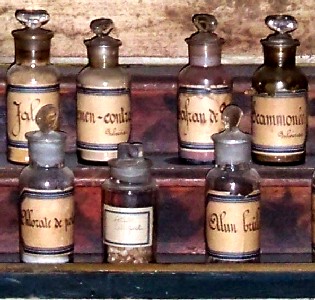
Photo: Véronique Pagnier - 18th c. Apothecary Bottles at
Carpentras Pharmacie, Hotel Dieu
Rx: "Troch. alhand. [Trochisci Alhandal (Lozenge of Alhandal)] {1 dram}, Pulv. Senna [powdered senna leaves] {1/2 dram} Sal niter [saltpeter] {1 scruple}, Mel com. [mell communis - honey] q.s. [as much as is sufficient] misce [mix]; boyl it to a fit consistance; f. suppositary [make it into a suppository]."2
Description: "Then for Suppositaries, you will have sometimes occasion for them, especially in foul weather, when a Clyster [enema] cannot be boyled."3
This is a very interesting comment from Moyle, providing some insight into life on a ship. Enemas were frequently used in medicine at this time because they were an important part of purging the body to purge unwanted bodily humors and to deliver medicines rectally. An enema was typically prepared as needed, usually requiring boiling. However, fires were not allowed to be lit when the ship was moving for fear that the coals would upset and accidentally set fire to the highly flammible ship - a vessel primarily made of wood, pitch and canvas at this time. So fires were not typically lit on the ship when the weather was stormy, the ship was underway or there was a battle going on. Thus, a suppository became the best way to deliver medicines rectally.
While Moyle cites this in his list of oft-used medicines, he does also note that a suppository "of Mel Angliæ and Bay Salt, boyled up, is oftener used at Sea."4
1,2,3,4 John Moyle, The Sea Chirurgeon, 1693, p. 27

